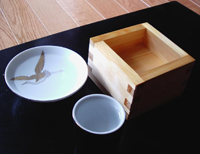
Sake (pronounced /ˈsɑːkiː/ or /ˈsɑːkeɪ/) is a rice-based alcoholic beverage of Japanese origin. In Japanese, sake or o-sake refers to alcoholic drinks in general, but the Japanese term for this specific beverage is actually Nihonshu, meaning "Japanese sake." The "shu" suffix means sake (酒), which can be seen in the Kanji (Japanese characters) for sake (酒), o-sake (お酒), and Nihonshu (日本酒).
How Is It Made?[]
A naturally fermented alcoholic beverage, sake is classified in the same general category as wine and beer. Sometimes mistakenly referred to as "rice wine," this is a misconception which is revealed when comparing the differing fermentation processes of sake, wine and beer. In wine, alcohol is produced by fermenting the sugar naturally present in fruit, while sake is produced using a brewing process closer to that of beer. The brewing process for sake differs from that of beer as well in that with beer, the conversion of starch to sugar, and then from sugar to alcohol occurs in two separate steps, whereas with sake these two steps are combined and occur simultaneously.

The rice used to make sake is not the same as the edible variety most people are familiar with. The starches used in the fermentation process are concentrated in the center of grains of sake rice. Encasing this starchy core, are fats and proteins that adversely affect fermentation and in general lead to off-putting flavors and aromas which are generally unwanted components in the flavor profile. To remove these undesirable ingredients, a milling process comes into play which eliminates varying amounts of this outer layer. Commonly called "polishing," the quality level of a sake is determined by how much of this layer is removed, with the highest quality sake made up almost exclusively of the inner starch core.
What's In It?[]
Sake is made from the simple ingredients of rice and water, and contains no preservatives. It is a great way to add unique flavor to your favorite dishes, and is commonly used in stir-fry, marinades, sauces and a variety of other recipes. Like beer and wine, sake is lower in both alcoholic content and calories when compared to distilled liquors such as vodka or bourbon. Unlike wine and distilled liquors, freshness is the key to good taste rather than aging. Generally speaking, six months is the freshness "shelf-life" of most sake - provided that it is either refrigerated, or stored in cool temperatures.
Serving[]
The Japanese often serve sake at a temperature to match the time of year or the style of food it will accompany. This custom is so widespread that the Japanese language itself includes special words for sake depending upon the temperature at which it is served. Warmed or slightly heated sake is called kan. When kan is served at 45°C (113°F), its fullness of body and mellow flavor become more pronounced making this a popular choice during the cooler months or when paired with refreshingly light fare. Enjoyed in this fashion, kan is particularly soothing.
Chilled sake is called hiya. Hiya generally assumes a fresh, fruity character and is particularly refreshing during warm weather, but can be equally enjoyable throughout the year. Some sakes are brewed specifically to be served chilled, such as many of the premium sakes. This is in order to preserve the subtle, delicate flavor that warming can destroy. Other sakes are brewed to be more versatile and tend to have a slightly heartier flavor that is enjoyable both chilled and warmed.

Traditional Japanese culture makes frequent use of sake as a way to observe a seasonal holiday or mark a special event. In this manner, sake is imbibed on such occasions as toasting the New Year, celebrating a local festival or solemnizing a wedding vow. Whether served in an antique porcelain cup or a small wooden cup (masu), whether spiced with herbs or garnished with flower petals, sake plays a special role in ceremonial aesthetics.
Today sake is most often enjoyed according to personal preference in casual atmospheres. Individuals may select the season, occasion, food, and surroundings that suit their own tastes.
Nutritional Information[]
On average, sake breaks down as follows:
- Protein: 0.5 g
- Fat: less than 0.1 g
- Sugar: 5 g
- Dietary Fiber: less than 0.1 g
- Calcium: 1.6 mg
- Iron: less than 0.1 mg
- Potassium: 2.9 mg
- Magnesium: 0.9 mg
- Vitamin B1: 3.0 mg
- Per 100 ml (3.3 oz.) serving
Calorie Comparison (Per 100 ml (3.3oz) serving)[]
- Sake: 105 ~ 110 cal.
- Beer: 40 ~ 70 cal.
- Wine: 80 ~ 100 cal.
- Whiskey: 225 ~ 250 cal.
Alcoholic Content Comparison[]
- Sake: 15-20% (30-40 proof)*
- Beer: 3-9% (6-18 proof)
- Wine: 9–16% (18-32 proof)
- Whiskey: 40-50% (80-100 proof)
*Sake is often diluted with water down to about 15% prior to bottling.
All items (3)
